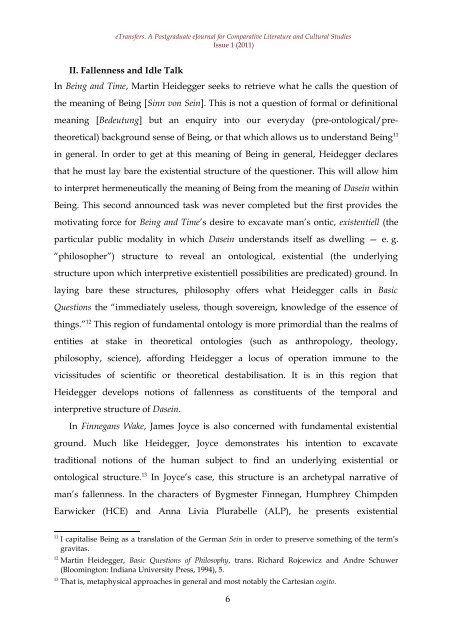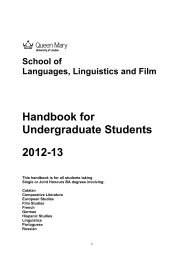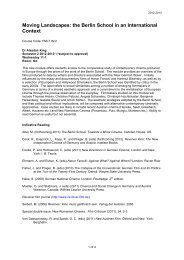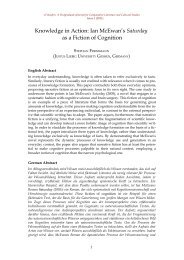Finnegans Wake - Queen Mary, University of London
Finnegans Wake - Queen Mary, University of London
Finnegans Wake - Queen Mary, University of London
Create successful ePaper yourself
Turn your PDF publications into a flip-book with our unique Google optimized e-Paper software.
eTransfers. A Postgraduate eJournal for Comparative Literature and Cultural Studies<br />
Issue 1 (2011)<br />
II. Fallenness and Idle Talk<br />
In Being and Time, Martin Heidegger seeks to retrieve what he calls the question <strong>of</strong><br />
the meaning <strong>of</strong> Being [Sinn von Sein]. This is not a question <strong>of</strong> formal or definitional<br />
meaning [Bedeutung] but an enquiry into our everyday (pre-ontological/pre-<br />
theoretical) background sense <strong>of</strong> Being, or that which allows us to understand Being 11<br />
in general. In order to get at this meaning <strong>of</strong> Being in general, Heidegger declares<br />
that he must lay bare the existential structure <strong>of</strong> the questioner. This will allow him<br />
to interpret hermeneutically the meaning <strong>of</strong> Being from the meaning <strong>of</strong> Dasein within<br />
Being. This second announced task was never completed but the first provides the<br />
motivating force for Being and Time’s desire to excavate man’s ontic, existentiell (the<br />
particular public modality in which Dasein understands itself as dwelling — e. g.<br />
“philosopher”) structure to reveal an ontological, existential (the underlying<br />
structure upon which interpretive existentiell possibilities are predicated) ground. In<br />
laying bare these structures, philosophy <strong>of</strong>fers what Heidegger calls in Basic<br />
Questions the “immediately useless, though sovereign, knowledge <strong>of</strong> the essence <strong>of</strong><br />
things.” 12 This region <strong>of</strong> fundamental ontology is more primordial than the realms <strong>of</strong><br />
entities at stake in theoretical ontologies (such as anthropology, theology,<br />
philosophy, science), affording Heidegger a locus <strong>of</strong> operation immune to the<br />
vicissitudes <strong>of</strong> scientific or theoretical destabilisation. It is in this region that<br />
Heidegger develops notions <strong>of</strong> fallenness as constituents <strong>of</strong> the temporal and<br />
interpretive structure <strong>of</strong> Dasein.<br />
In <strong>Finnegans</strong> <strong>Wake</strong>, James Joyce is also concerned with fundamental existential<br />
ground. Much like Heidegger, Joyce demonstrates his intention to excavate<br />
traditional notions <strong>of</strong> the human subject to find an underlying existential or<br />
ontological structure. 13 In Joyce’s case, this structure is an archetypal narrative <strong>of</strong><br />
man’s fallenness. In the characters <strong>of</strong> Bygmester Finnegan, Humphrey Chimpden<br />
Earwicker (HCE) and Anna Livia Plurabelle (ALP), he presents existential<br />
11 I capitalise Being as a translation <strong>of</strong> the German Sein in order to preserve something <strong>of</strong> the term’s<br />
gravitas.<br />
12 Martin Heidegger, Basic Questions <strong>of</strong> Philosophy, trans. Richard Rojcewicz and Andre Schuwer<br />
(Bloomington: Indiana <strong>University</strong> Press, 1994), 5.<br />
13 That is, metaphysical approaches in general and most notably the Cartesian cogito.<br />
6







